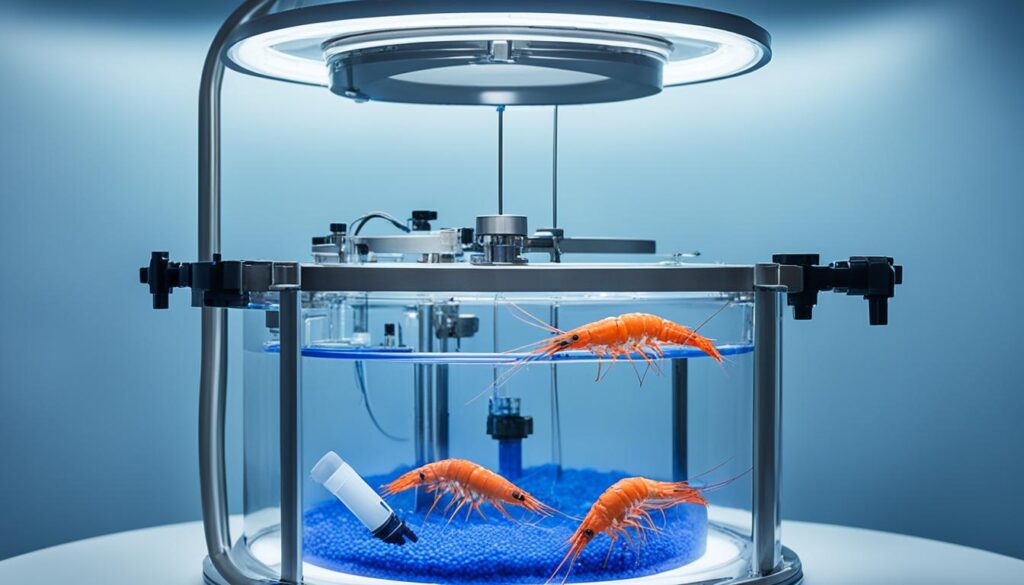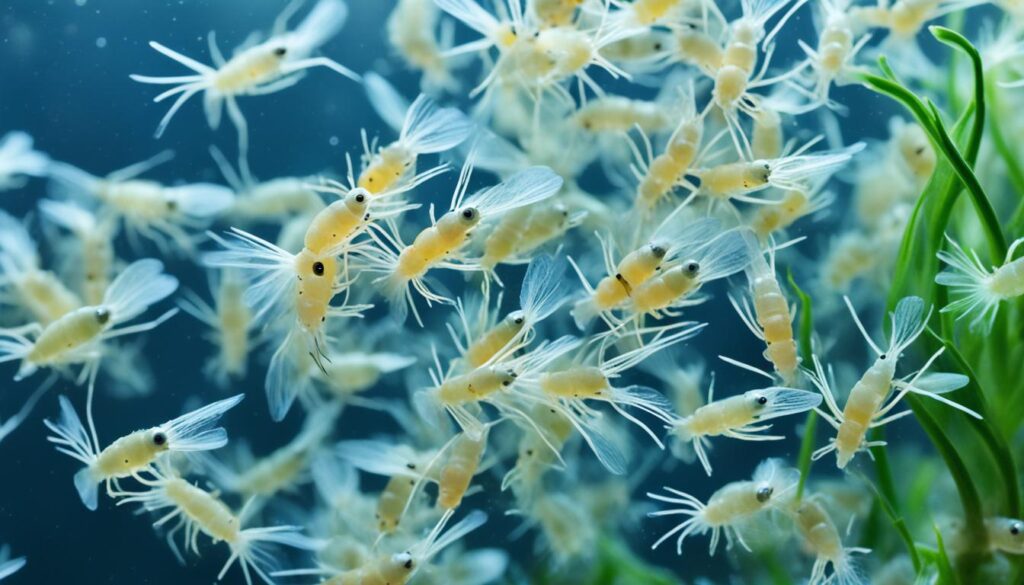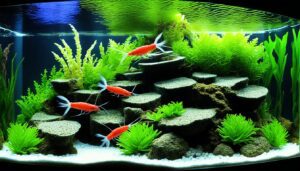Welcome aquarists! As someone who loves shrimps and has learned a lot about them, I’m here to share what I know. Let’s talk about non-breeding shrimp. Many enjoy the easy-to-care-for Red Cherry shrimp. However, today is about those shrimp that don’t multiply in your tank.
Some people like a tank without baby shrimp everywhere. They might want fewer shrimps or not deal with baby shrimp care. That’s why they like Amano shrimp (Caridina multidentata). These shrimp love to eat algae. Plus, they won’t have babies in fresh water, so your tank won’t get crowded.
Ghost shrimp are fascinating too. Some can have babies in fresh water. But others need salty, brackish water and won’t breed in a regular tank. This makes them a great choice if you don’t want shrimp babies.
Thinking if these non-breeding shrimps are good for your tank? Check out The Shrimp Farm for advice. It’s a great site for both new and experienced shrimp fans. You can find tips on choosing and caring for shrimp there.
Shrimp Breeding Behavior in Freshwater Environments

Shrimp breeding in freshwater is key to their reproduction management. Different species need unique conditions that aren’t always met in aquariums. Some shrimp can’t breed in freshwater because the right conditions are missing.
Why Some Shrimp Species Don’t Reproduce in Freshwater
Some shrimp naturally prevent breeding in aquariums. For example, Amano shrimp need brackish water as larvae to grow. These shrimp reach adulthood without reproducing in freshwater. This fact is vital for those who want to control shrimp population.
The Role of Salinity in Shrimp Reproduction
Salinity levels are crucial for some freshwater shrimp’s life cycle. Species like Opae ula need specific salinity to breed, which isn’t found in most tanks. Adjusting tank salinity can control shrimp breeding.
The Unique Lifecycle of Amano Shrimp and Other Non-Breeders
Amano shrimp have a unique breeding behavior. They need specific salinity absent in freshwater tanks. This behavior helps in studying shrimp sterilization and preventing overpopulation.
Characteristic |
Neocaridina |
Caridina |
|---|---|---|
Average Lifespan |
1-2 years |
1-2 years |
Optimal Temperature Range (F) |
65-84 |
64-76 |
Preferred pH Level |
6.5-8 |
6-7.5 |
General Hardness (dGH) |
4-8 |
4-6 |
Total Dissolved Salts (ppm) |
200-300 |
100-200 |
Understanding shrimp breeding and their needs enriches the hobby. It also boosts the health and sustainability of aquarium ecosystems.
Shrimp That Don’t Breed in Home Aquariums

Knowing how non-breeding shrimp act in home aquariums helps keep the ecosystem balanced. Some shrimp, like Amano shrimp, Ghost Shrimp, and others from the Atyopsis genus, can’t breed in normal freshwater setups. They have special behaviors and needs that stop them from having babies in common conditions.
Amano Shrimp – The Algae Cleaners
Amano shrimps are great at eating lots of algae, serving as natural cleaning agents. They can grow up to 2 inches, which helps them clean effectively. Yet, breeding them is hard because their babies need brackish water to survive, something not found in most freshwater tanks.
Non-Breeding Ghost Shrimp Varieties
Ghost Shrimp are strong and can handle different water types. They’re often used as food for other fish. But their babies need very specific conditions to grow, which are hard to copy at home. This makes them non-breeders in residential aquariums.
Bamboo, Wood, and Flower Shrimp – Different Names, Same Non-Breeder
Bamboo Shrimp, Wood Shrimp, and Flower Shrimp are all Atyopsis genus shrimp. They have unique fan-like parts for feeding and are interesting to watch. They won’t breed in normal freshwater tanks, making it easier for tank owners to manage shrimp numbers.
Learning about non-breeding shrimp, like Amano and Ghost Shrimp, helps in choosing the right types for your tank. It also sets the right expectations about their reproduction and controlling their numbers.
Preventing Shrimp Breeding: Techniques and Shrimp Sterilization
As an aquarist, keeping my shrimp ecosystem balanced is crucial. Shrimp breeding inhibition at home means choosing the right species and managing the tank’s environment. My aquarium, prepared for over two months, provides a stable setting for my shrimp. This avoids the need for shrimp sterilization techniques. Shrimp health demands ammonia levels under 0.25 ppm, no nitrites, and low nitrates.
To keep my shrimp thriving, I do regular water changes. This keeps nitrate levels below 40 ppm and prevents breeding.
Choosing Amano Shrimp and other non-breeding species keeps my tank calm. With no offspring, my workload is lighter, without complex preventing shrimp breeding efforts. I keep dGH at 6, and adjust calcium and magnesium as needed. With a diet of fish filet or shrimp once a week, I avoid extra food that could cause issues.
Good biosecurity is also key in my tank care. I use techniques like sterilized water treated with UV and air filters, following research recommendations to avoid Vibrio infections. My filtration uses an air-driven sponge filter, making the tank safe for all shrimp. Regular cleaning keeps diseases at bay. For professional tips, I refer to Kate Wu’s insights on Vibrio prevention during shrimp seeding.








